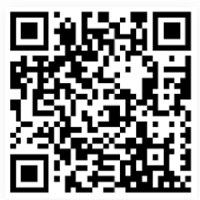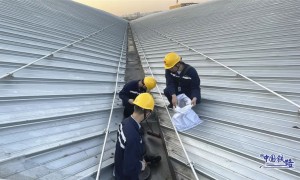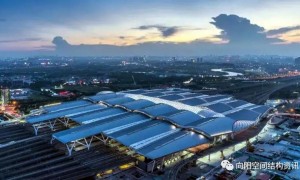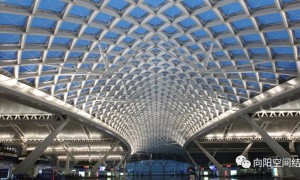这是美国旧金山一个正在施工的13层公寓建筑。和国内各种吃播,各种带货不同的是,油管上有很多特殊视频直播创作,比如这个作者,他的直播内容就是对着对面的建筑工地,直播整个建造过程……
这个工地刚好从2020年年初开始,该up主每周把视频素材汇总整理一集,正好借此机会,可以从第三方的角度,了解学习美国的施工组织设计,以及用到的一些工具,工法和国内有什么不同。
2020年3月4日,星期三。
继续土方作业。施工面A区局部已经开挖到设计标高,准备垫层施工。
今天工地出现一个小靓女,拿着一个机器插进土里,并且记录了一些数据。这是啥东西?
这是一种核密度测定法,用来测定土壤的密实度含水率等,文末有扩展说明。
补充知识:
Nuclear densitometry is a technique used in civil construction and the petroleum industry, as well as for mining and archaeology purposes, to measure the density and inner structure of the test material. The processes uses a nuclear density gauge, which consists of a radiation source that emits particles and a sensor that counts the received particles that are either reflected by the test material or pass through it. By calculating the percentage of particles that return to the sensor, the gauge can be calibrated to measure the density.
核密度测定法是一种用于民用建筑和石油工业,以及采矿和考古目的的技术,以测量测试材料的密度和内部结构。该过程使用一个核密度计,该计由一个发射粒子的辐射源和一个传感器组成,该传感器对接收到的被测试材料反射或通过测试材料的粒子进行计数。通过计算返回到传感器的粒子的百分比,测量仪可以校准来测量密度。
In geotechnical engineering, a nuclear densometer or soil density gauge is a field instrument used to determine the density of a compacted material. The device uses the interaction of gamma radiation with matter to measure density, either through direct transmission or the “backscatter” method. The device determines the density of material by counting the number of photons emitted by a radioactive source (cesium-137) that are read by the detector tubes in the gauge base. A 60-second time interval is typically used for the counting period.
在岩土工程中,核密度计或土壤密度计是一种现场仪器,用来测定压实材料的密度。该装置利用伽马辐射与物质的相互作用,通过直接传输或“后向散射”方法来测量密度。该设备通过计数辐射源(铯-137)发出的光子数来确定物质的密度,这些光子数由位于测量仪底座上的探测管读取。计算周期通常使用60秒的时间间隔。
Different variants are used for different purposes. For density analysis of very shallow objects such as roads or walls, a gamma source emitter such as 137Cesium is used to produce gamma radiation. These isotopes are effective in analyzing the top 10 inches (25 centimeters) with high accuracy. 226Radium is used for depths of 328 yards (300 meters). Such instruments can help find caves or identify locations with lower density that would make tunnel construction hazardous.
不同的变体用于不同的目的。对于非常浅的物体(如道路或墙壁)的密度分析,使用像137铯这样的伽马源发射器来产生伽马辐射。这些同位素在分析顶部10英寸(25厘米)的高精度上是有效的。226镭用于深度328码(300米)。这类仪器可以帮助寻找洞穴或识别密度较低的位置,而密度较低的位置会使隧道施工变得危险。
Ground compaction
A nuclear densometer is used on a compacted base to establish its percentage of compaction.[2][3] Before field tests are performed, the technician performs a calibration on the gauge which records the ‘standard count’ of the machine. Standard counts are the amount of radiation released by the two nuclear sources inside the machine, with no loss or leakage. This allows the machine to compare the amount of radiation released to the amount of radiation received. With the use of a 3/4″ diameter rod a hole is created in the compacted base by hammering the rod into the base to produce a hole that the densometer’s probe can be inserted into. The densometer is placed on top of the hole, and then the probe is inserted into the hole by unlocking the handle at the top of the probe. One source produces radiation that interacts with the atoms in the soil, and is then compared to the standard count, to calculate the density. The other source interacts with hydrogen atoms to calculate the percentage of water in the soil.
核密度计在压实基础上使用,以确定压实率。在进行现场测试之前,技术人员对记录机器“标准计数”的量规进行校准。标准的计数是指机器内部的两个核源释放的辐射量,没有损失或泄漏。这使得机器可以比较释放出的辐射量和接收到的辐射量。使用一个3/4”直径的杆,一个孔是通过锤击杆到基地产生一个孔,密度计的探头可以插入。密度计放在孔的顶部,然后通过解锁探针顶部的把手将探针插入孔中。其中一种辐射源产生的辐射与土壤中的原子相互作用,然后与标准计数进行比较,以计算密度。另一个来源与氢原子相互作用来计算土壤中水分的百分比。
In direct transmission mode, the source extends through the base of the gauge into a predrilled hole, positioning the source at the desired depth. The testing procedure is analogous to burying a known quantity of radioactive material at a specific depth, and then using a Geiger counter at the ground surface to measure how effectively the soil’s density blocks the penetration of gamma radiation through the soil. As the soil’s density increases, less radiation can pass through it, owing to dispersion from collisions with electrons in the soil being tested.
在直接传输模式下,源通过量规的底座延伸到预钻的孔中,定位源在所需的深度。测试过程类似于将已知数量的放射性物质埋在特定深度,然后在地表使用盖革计数器来测量土壤密度如何有效地阻止伽马辐射穿透土壤。随着土壤密度的增加,由于与被测土壤中的电子发生碰撞而分散,通过土壤的辐射就会减少。
Since the soil’s moisture level is partly responsible for its in-place density, the gauge also contains a neutron moisture gauge consisting of an americium/beryllium high-energy neutron source and a thermal neutron detector. The high-energy neutrons are slowed when they collide with hydrogen atoms, and the detector then counts the “slowed” neutrons. This count is proportional to the soil’s water content, since the hydrogen in this water (H2O) is responsible for almost all the hydrogen found in most soils. The gauge calculates the moisture content, subtracts it from the soil’s in-place (wet) density, and reports the soil’s dry density.
由于土壤的湿度水平是决定其密度的部分因素,该计还包含一个由镅/铍高能中子源和热中子探测器组成的中子湿度计。当高能中子与氢原子碰撞时,它们的速度会变慢,然后探测器就会计算“减速”的中子。这一数量与土壤的含水量成正比,因为大多数土壤中几乎所有的氢都来源于水中的氢。该仪器计算出土壤的水分含量,从土壤的原位(湿)密度中减去它,然后报告土壤的干密度。
Density of liquids in pipes[edit]
管道中液体的密度
Nuclear density gauges can also be used to measure the density of a liquid in a pipe. If a source is mounted on one side of a pipe and a detector on the other, the amount of radiation seen at the detector is dependent upon the shielding provided by the liquid in the pipe. Tracerco pioneered the use of radiation to measure density in the 1950s and determined that the Beer–Lambert law also applied to radiation as well as optics. Gauges are normally calibrated using gas and a liquid of known density to find the unknowns in the equation. Once it has been calibrated and as long as the source detector alignment remains constant, it is possible to calculate the density of the liquid in the pipe. One factor is the half life of the radioactive source (30 years for 137Cs), which means that the system needs to be recalibrated at regular intervals. Modern systems incorporate correction for source decay.[4]
核密度计也可以用来测量管道中液体的密度。如果一个源安装在管道的一侧,一个探测器安装在另一侧,在探测器上看到的辐射量取决于管道中液体提供的屏蔽。Tracerco在20世纪50年代率先使用辐射测量密度,并确定比尔朗伯定律也适用于辐射和光学。仪表通常使用已知密度的气体和液体进行校准,以找到方程中的未知数。一旦它被校准,只要源探测器对齐保持不变,就可以计算出管道中液体的密度。一个因素是辐射源的半衰期(137Cs为30年),这意味着系统需要定期重新校准。现代系统包含了对源衰减的校正
Locating underground water[edit]
定位地下水
Another variant is to use a strong neutron source like 241Americium/Beryllium to produce Neutron radiation and then measure the energy of returning neutron scattering. As hydrogen characteristically slows down neutrons, the sensor can calculate the density of hydrogen – and find pockets of underground water, humidity up to a depth of several meters, moisture content, or asphalt content.
另一种方法是使用像241镅/铍这样的强中子源来产生中子辐射,然后测量返回中子散射的能量。由于氢减慢了中子的速度,传感器可以计算出氢的密度——并发现地下水的小块,几米深的湿度,水分含量,或沥青含量。







